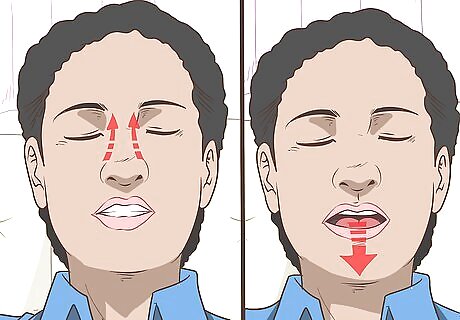
views
X
Trustworthy Source
Association for Psychological Science
Nonprofit organization devoted promoting trustworthy research and education in the psychological sciences
Go to source
While you should address chronic fear or anxiety with the help of a professional, there are some situations when you just need to get through your fear so that you can move on. In such times, you can distract yourself by using a calming method to cleanse your mind of fearful thoughts, or by focusing on other activities to reorient your mood.
Focusing on Other Activities

Watch a comedy or read a magazine. You might have noticed that the waiting rooms of dentist and doctor offices are filled with celebrity gossip and fashion magazines. Some therapists theorize that this generic choice is calculated specifically to distract fearful patients from their upcoming procedures: the genre and topic is far-removed from the current situation and fear, so it works particularly well as a distraction. For example, if you start to feel fearful when you are lying in bed at night, turn on your favorite comedy show or pull out your favorite magazine and read through it until you feel less fearful. If you don’t like magazines, put on a funny podcast, a stand-up comedy special, or a light-hearted comedic film. You’ll be surprised how much the natural response of laughing can distract you from and even directly diminish the fear you’re experiencing.

Try a focused activity like cooking or exercising. Studies have shown that distraction can be an effective way to get through fear or anxiety, but some distractions are better than others. Rather than letting your mind wander to a variety of other subjects, focus on one thing in particular, such as a physical activity, a good book, cleaning your house, taking a class, or attending to a task from your work. Yoga can be a particularly good physical exercise for distraction, as it helps hone concentration skills and develop mindfulness strategies. For example, if you start to feel fearful during finals for school, head to your local gym for a yoga class. Or avoid the fear of studying by preparing a meal at home.

Talk to a friend or family member. Studies have shown that talking out your fears can help to overcome them. If you don’t feel comfortable explicitly discussing your fears, though, you can distract yourself from the fear by socializing with someone. You’ll have to concentrate on the ongoing conversation, so you won’t have nearly as much mental bandwidth to dedicate to your fear. If you’re afraid at night, have a friend come over and spend the night. Even if you’re not talking through your fears directly, you’ll find the companionship redirects your attention. If you’re alone and no one can meet you, call a family member or a fun friend on the phone. Even the mundane topics of a casual conversation will distract you from your fears and help you survive the situation. For example, if you start to feel fearful alone in your apartment, call a friend and ask them to go to dinner with you. Or reach out to a family member and chat with them on the phone to distract you from your fears.

Take care of a pet, friend, or child. You might have heard the axiom that the best way to get rid of the blues is to cheer someone else up. A similar principle is at work when you attend to someone else when you’re frightened or anxious: instead of focusing on your internal thoughts, you direct your attention outward. For example, ask a friend if they need a babysitter, take your dog for a walk, play with your cat, or help a friend talk through a conflict. If you struggle with fear often, consider volunteering for a local charity. Studies have shown that household pets are particularly effective at reducing anxiety and improving quality of life, even for people with high-stress lifestyles and jobs.
Replacing Fear with a Calm Mindset

Practice deep breathing. Some of the more unpleasant physical symptoms of fear include an accelerated heartbeat, perspiration, and a knotted or upset stomach. You can ease these symptoms by breathing deeply and slowly. As you focus on a physical process you can control, you distract yourself from the spiraling mental and emotional processes in your head. You can sit upright or lie flat on your back while practicing deep breathing. Inhale slowly through your nose so that you feel your lungs and abdomen expand, then exhale slowly through your mouth.

Close your eyes and imagine you’re in a safe, serene place. Your imagination can be a powerful tool against fear. By picturing yourself in a place you associate with happiness and personal security, you distance yourself from current anxiety and replace negative feelings with positive ones. For example, picture a sunset-shouldered beach, your cozy bed at home, a favorite retreat from childhood, or a secluded cabin in the middle of the forest.

Meditate through your fear. It will take some practice, but meditation is one of the best ways to distract yourself from and eventually overcome fear. It helps you empty your mind of negative or worrying thoughts, focus on present physical sensations, and attain a sense of balance and self-control. If you’re new to meditation, start by practicing in three to five minute sessions and focus on your breathing and minute-by-minute physical sensations.

Think about your positive traits. One of the best ways to get rid of negative thoughts and feelings of dread is to reorient the tone of these thoughts. Instead of worrying about bad things that could happen, focus on the positive aspects of life and yourself that you already have. Not only can this method be effective for surviving and overcoming temporary bouts of fear, but it can have long-term impacts on social confidence and self-control. For example, think about something good you did for someone the previous day or week, appreciate your family members or friends to whom you’re grateful, review an inventory of things you like about yourself, or recall a fun memory.

Listen to soothing music or natural sounds. While peaceful music might not be sufficiently distracting in high-stress situations or panic attacks, it can be a useful distraction during moments of mild, customary discomfort. For example, switch on some slow-tempo tunes when you’re waiting to board a flight and have a case of pre-flight nerves or you’re on the way to a job interview. Classical, jazz, trance, and blues can all be particularly calming genres of music.

Avoid potentially harmful distractions, such as alcohol or drugs. There’s nothing wrong with sipping a glass of wine when you want to unwind, but you shouldn’t rely on this substance to get you through bouts of fear and anxiety. Not only are drugs and alcohol only temporarily distracting, but they can actually make fears worse and anxiety pattern cyclical.
Finding the Root of Your Fears

Acknowledge your fear-based emotions. If you find that distracting yourself from your fears is not effective, you may want to consider finding the root cause of your fears. To do this, start by acknowledging your fear-based emotions. Whenever you have a moment of fear, take a deep breath and acknowledge your fear. Say to yourself, “I am feeling fear right now and that is okay.” Try to get in the habit of acknowledging your fear, rather than try to avoid it or distract yourself from it. Rather than respond emotionally to the fear, simply acknowledge that it is there and be more aware of it. View it logically as a feeling you are experiencing and try not to run away from it or avoid it.

Process your fears. Once you acknowledge your fears, you can then start to process them. Ask yourself, “Why am I feeling fear right now?” Consider the situation you are in, the people around you, if any, and any other external factors. Think about your day and whether certain moments or situations in your day may have contributed to your feelings of fear. Work on processing your fears so you can gain control over them. You may need to take a few deep breaths and sit somewhere quiet to really process your fears. Take your time and meditate on how you are feeling as well as the possible root causes of your fears.

Speak to a professional about your fears. If you have a specific fear, such as a fear of heights or a fear of crowded places, then you can work with a mental health professional to treat your fear using cognitive behavioral therapy and other techniques. If you are struggling to acknowledge and process your fears on your own, consider talking to a therapist or counselor about your fears. Get a recommendation from your primary care doctor for a therapist in your area. Go to a local mental health clinic to talk to a therapist. Reach out to a school counselor if you are student and need professional support. You can also call a mental health hotline like the SAMSHA Treatment Referral Hotline in the U.S, 1-877-726-4727. Through the hotline, you can get a referral to a mental health professional in your area so you can find a therapist or counselor to talk to.




















Comments
0 comment